Japan’s housing market remains buoyant
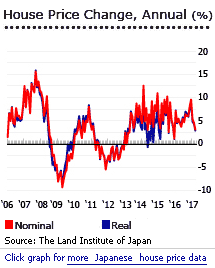 Japan’s housing market remains upbeat, despite slow economic growth. House prices continue to rise strongly. Property demand islargely stable, and residential construction activity is rising.
Japan’s housing market remains upbeat, despite slow economic growth. House prices continue to rise strongly. Property demand islargely stable, and residential construction activity is rising.
Japan’s overall residential property price index rose by 4.7% (4.2% inflation-adjusted) in January 2017 from the same period last year, according to the Ministry of Land, Infrastructure, Transport and Tourism (MLIT). Nationwide, condominium prices were up by 5.2%, detached house prices increased 2.7% and residential land prices rose by 4.8% over the same period.
In Tokyo Metropolitan Area:
- Existing condominium units’ average prices rose by 3.1% to JPY492,800 (US$4,378) per sq. m. during the year to end-Q1 2017, according to the Land Institute of Japan (LIJ).
- New condominium units’ average prices dropped slightly by 1.5% y-o-y to JPY790,000 (US$7,018) per square metre (sq. m.) in Q1 2017.
- Existing average detached house prices increased 1.4% to JPY33,700,000 (US$299,391) over the same period.
In Osaka Metropolitan Area:
- Existing condominium units’ average prices increased 2.7% to JPY305,000 (US$2,710) per sq. m. during the year to Q1 2017.
- New condominium units’ prices fell by 2.2% to JPY622,000 (US$5,526) per sq. m. over the same period.
- Existing detached house prices were down by 2.1% to JPY20,660,000 (US$183,543) over the same period.
While the impact of "Abenomics” - i.e., the reflationary policies of Prime Minister Shinzo Abe, who came to power in December 2012 – on the wider economy is debatable, the policy has undoubtedly helped prop up Japan’s property market and boosted residential construction activity.
Abenomics stimulates the economy by increasing public infrastructure spending, devaluing the yen and aggressive quantitative easing by the Bank of Japan (BOJ). Since the introduction of Abenomics, real estate prices have accelerated strongly. Transactions started to pick up in 2012 and rose rapidly in 2013, as monetary policy kicked in.
House prices are expected to continue rising in the coming months, as a fresh round of economic stimulus was initiated in the second half of 2016. Moreover, Tokyo’s successful bid to host the 2020 Summer Olympics should boost property demand and construction over the next 7 years.
From a US$-based investor´s perspective, the Japanese residential market´s gains was bolstered by the 12.3% appreciation of the Japanese Yen from ¥123.725 = US$1 in June 2015, to ¥110.177 = US$1 in April 2017. However, this was not enough to offset the 37% drop in the value of yen against the dollar from 2012 to 2015.
The Japanese economy grew by 1% in 2016, after y-o-y growth of 1.2% in 2015, 0.3% in 2014, 2% in 2013, and 1.5% in 2012. The economy is expected to grow by 1.2% this year and by another 0.6% in 2018, according to the International Monetary Fund (IMF).
Residential property sales variations
Residential property sales continue to rise in Tokyo; but demand is more subdued in Osaka.
- In Tokyo, the number of existing condominiums sold rose by 3.7% to 3,735 units in March 2017 from the same period last year, according to LIJ. Likewise, existing detached house sales rose by 5.5% y-o-y to 1,901 units.
- In Osaka, existing condominiums sold fell by 1.7% y-o-y to 1,764 units in March 2017, while existing detached houses sales dropped 5.1% to 1,262 units.

Land sales are rising in both major cities. In Tokyo, lots sold increased 6.3% to 1,195 units in March 2017 from the same period last year. In Osaka, land sales rose by 3.8% to 272 units over the same period.
Housing supply increasing
Authorized housing starts increased 3.2% to 223,290 units in Q1 2017 from the same period last year, according to the MLIT. Housing starts rose in 2016, by 6.4% y-o-y to 967,237 units, after rising slightly by 1.9% in 2015.
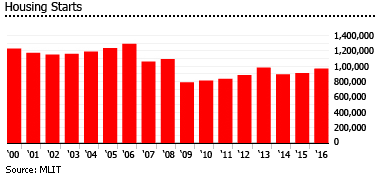
All major areas saw an increase in residential construction activity. In Q1 2017:
- In Tokyo Metropolitan Area, the number of housing starts rose strongly by 8.1% to 83,554 units from a year earlier.
- In Osaka Metropolitan Area, housing starts increased slightly by 1.3% y-o-y to 29,069 units.
- In Nagoya Metropolitan Area, housing starts rose slightly by 1.2% y-o-y to 17,755 units.
- In other areas, housing starts increased by a meager 0.1% y-o-y to 92,912 units.

In Tokyo, 11% more new condominiums were put on the market in Q1 2017 compared to a year earlier, according to LIJ. In contrast in Osaka, there was a 7% decline in the number of new condominiums put on the market.
Japan´s shrinking population is producing a surplus of housing units
It is estimated that Japan will lose a third of its population over the next 50 years. In addition, about 40% of the population will be over 65 years old by 2060.
“Based on our projections, the size of the annual decline will keep getting bigger before peaking somewhere between 2060 and 2070,” said Futoshi Ishii of the National Institute of Population and Social Security Research.

The shrinking population is already producing a surplus of housing units. There are many sightings of abandoned homes in Tokyo. There are already an estimated 8.2 million unoccupied homes in the country, representing 13.5% of all residences,and up 24.4% from a decade ago, according to MLIT. Japan has a total of 60.63 million residences, 16% more than the total number of households of 52.45 million.
However, declining household sizes may mitigate the situation. The average household size is projected to decline to 2.37 by 2025, from 2.67 in 2000, and 5.0 in 1950, according to the Ministry of Internal Affairs and Communication. More Japanese are living alone and fewer are living in multiple-generation households, increasing the demand for quality housing.
In an effort to reduce the total number of abandoned homes, some abandoned houses and apartments are being put back on the market by the Ministry of Land, Infrastructure, Transport and Tourism, as part of its new 10-year national housing plan. The plan also proposes to offer some of these houses to low-income earners and families with children, and to replace aging condominiums.
The government is also trying to stop the Japanese population shrinking:
- Childcare provision was boosted by the Act on Child and Childcare Support of August 2012.
- The Comprehensive Support System for Children and Child-rearing, introduced in April 2015, will promote early childhood school education, childcare and child-rearing support services in local communities.
- The government is expected to approve enhanced support for families with three or more children.
- Local governments are being encouraged to offer speed dating and other forms of matchmaking, and to support marriage, child-bearing and child-rearing.
- The government is expanding free nursery care.
- The government also plans to establish fertility treatment counselling centres in major cities.
- The government has also been discussing accepting more immigrants – a possible solution to maintain its population and counter its dwindling workforce.
Moderate rental yields, stable rents
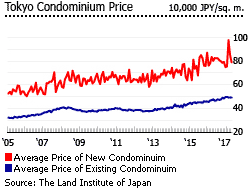
In Tokyo’s central districts, gross rental yields - the return earned on the purchase price of a rental property, before taxation, vacancy costs, and other costs - range from 3.4% to 5.4%, according to Global Property Guide research conducted in April 2016.
Yields are a little higher on smaller apartments. Yields on the very smallest apartments are 5.42%, a reasonable yield. But then smaller apartments tend to need more maintenance, so a higher yield is justified.
Rents are stable. In 2016, the nationwide apartment rent index rose by a meager 0.1% from a year ago, based on figures from the Japan Real Estate Institute.
In the country’s metro areas:
- In Tokyo Metropolitan Area, apartment rents increased 0.3% y-o-y in 2016.
- In Osaka Metropolitan Area, apartment rents dropped 0.2% y-o-y in 2016.
- In Nagoya Metropolitan Area, apartment rents were unchanged in 2016 from a year earlier.
New housing loans rising strongly
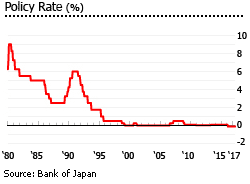
In April 2017, the BOJ kept its key interest rate steady at -0.1%. The key rate became negative in January 2016. This means that lenders will be charged to keep their money with the central bank.
The BOJ’s key rate has been below 1% since mid-1990s. As a result, the prime lending rates in principal banks in Japan have hardly moved since 2000, remaining below 3%.
Due to BOJ’s move to maintain the key rate, Resona Bank and Sumitomo Mitsui Trust Bank, two of the country’s five major banks, held their mortgage rates unchanged in April 2017, at 0.95% and 0.55%, respectively. On the other hand, the Bank of Tokyo-Mitsubishi UFJ (MUFJ) and Sumitomo Mitsui Banking Corporation (SMBC) raised interest rates for 10-year fixed mortgage loans to 1.05% in April 2017. Likewise, Mizuho Bank also edged up its 10-year rate to 0.9%.
A decade ago, fixed mortgages in Japan were around 3%.
Due to very low interest rates, new housing loans from domestically-licensed banks surged 27% in 2016 from a year earlier, according to the Bank of Japan (BOJ).
The amount of housing loans in Japan is much lower than in other developed countries. The ratio of outstanding mortgage loans to GDP in Japan stood at around 22.5% in 2016, almost unchanged from a year earlier.
The "lost decade" and after

The Japanese economy continues to disappoint. In 2016, the economy expanded by a minuscule 1%, after growth of 1.2% in 2015, 0.3% in 2014, and 2% in 2013, according to the IMF.
Japan has never fully recovered from the great asset bubble of the late 1980s, and this slow growth is the reason that Abenomics was adopted. “Abenomics” includes the following:
- Inflation targeting at 2%
- Correction of the excessive appreciation of the yen
- Negative interest rates
- Radical quantitative easing
- Expansion of public investment
- Buying of construction bonds by the Bank of Japan
- Revision of the Bank of Japan Act
The BOJ introduced negative interest rates at the start of 2016 and adopted an even more accommodative monetary policy in September 2016 under the name “Quantitative and Qualitative Monetary Easing with Yield Curve Control.” This means that the central bank controls short-term and long-term interest rates through market operations and will expand the monetary base to reach the desired level of inflation. In terms of fiscal policy, PM Shinzo Abe encouraged more public spending and postponed a rise in the consumption tax rate (from 8% to 10%) for the second time in two years to October 2019.
However none of this has been very successful.
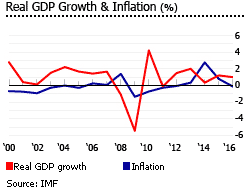
The property market has benefited the most. The wider economy is not doing so well, however.
After the ‘lost decade’ after the 1990’s, from 2000 to 2007 the Japanese economy grew by an average of 1.5% annually. However due to the global financial meltdown, the economy contracted by 1.1% in 2008 and by another 5.5% in 2009.
The economy bounced back in 2010 with 4.2% growth. Then in 2011 GDP shrank by 0.11% due to the Great Tohoku Earthquake (magnitude 9.0), and China’s economic slowdown. Anti-Japanese feeling sparked by the Diaoyu/Senkaku Islands dispute didn’t help. Japan’s economy grew by a modest 1.5% in 2012, and performance since then has been poor. The economy is expected to grow by 1.2% this year and by a meager 0.6% in 2018, according to the IMF.
This is a major blow for Prime Minister Shinzo Abe growth plan. Japan faces a long-term growth slowdown, and it is not obvious that Abenomics is the cure. But if not that, then what?
Improving trade balance
In the past ten months, the yen gained almost 12.3% against the dollar,from ¥123.725 = US$1 in June 2015, to ¥110.177 = US$1 in April 2017, and has moved up strongly against all major currencies since the Brexit vote.A strong yen is bad news for the economy and many Japanese companies as it makes Japanese products more expensive internationally and makes it much harder for the government to tackle deflation due to cheaper imports. The Japanese yen had previously moved significantly in the desired direction since 2012, depreciating by about almost 37% from US$1 = ¥78 in 2012 to US$ = ¥123 in 2015 - so this reversal is a disappointment.
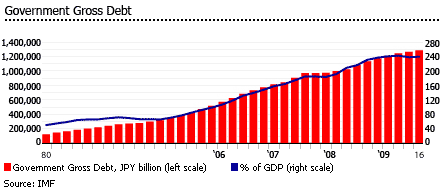
Nevertheless despite the currency´s appreciation exports grew 12% y-o-y to JPY7.2 trillion (USD64 billion) in March 2017, the strongest expansion since January 2015 and the fourth consecutive month of y-o-y gains, thanks to strong demand for auto parts and optical instruments, according to Finance Ministry. Likewise, imports rose by 15.8% y-o-y to JPY6.6 trillion (USD58.6 billion) in March 2017 due to rising oil and coal purchases.
The primary reason for the currency´s rise is that Japan’s trade balance improved sharply last year, thanks to a decline in energy import costs. In 2016, Japan posted a trade surplus of JPY4.01 trillion (US$35.6 billion), according to the Finance Ministry, its first year of trade surplus since the 2011 Fukushima nuclear disaster, which sent energy import bills soaring.
Despite Abenomics, inflation remains far below target

Abenomics was intended to stimulate the economy, partly by generating inflation. Yet Japan’s core inflation, excluding volatile food prices, increased by just 0.2% in March 2017, still far below the BOJ’s official target of 2%.
Aside from maintaining its -0.1% key interest rate, the central bank’s policy also consisted of government bond purchases to the tune of JPY 80 trillion (US$711 billion) annually. Moreover in July 2016, the BOJ stepped up its pace of monetary easing, adding JPY2.7 trillion (US$24 billion) of equity funds to its annual asset-buying program. The latest move is expected to almost double the BOJ’s purchases of equity exchange-traded funds from the current JPY3.3 trillion (US$29.3 billion) a year.
Abe was re-elected unopposed as head of the ruling Liberal Democratic Party (LDP) in September 20, 2015. His new term will run until September 30, 2018.
Abe is not giving up. The government unveiled a new JPY28 trillion (US$249 billion) stimulus package in July 2016 – the third in a row after a JPY10.3 trillion (US$91.5 billion) round in 2013 and a JPY3.5 trillion (US$31 billion) package in 2014.
The government vowed that it would abandon its massive stimulus only after inflation reaches 2%.
“Talking about a specific exit strategy now would cause undue confusion in markets,” said BOJ Governor Haruhiko Kuroda. “The prerequisite for such debate to happen is for inflation to achieve 2 percent.”
Japan has the world’s biggest debt burden. In 2016, the country’s gross debt amounted to JPY1,285 trillion (US$11.42 trillion), equivalent to about 239% of GDP, according to the IMF. Opinions differ about how much of a problem this is.